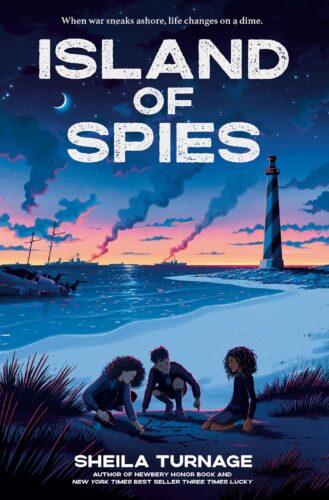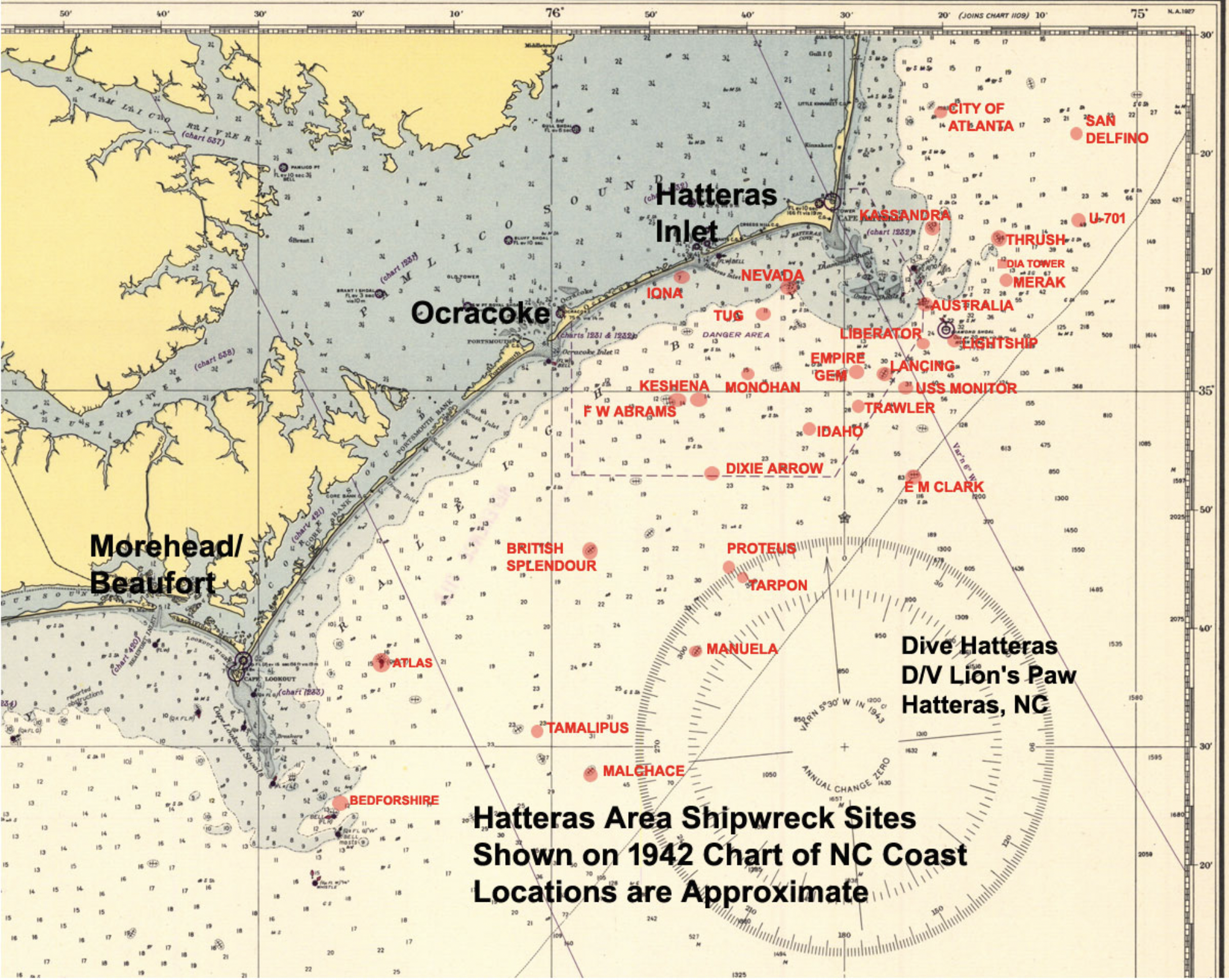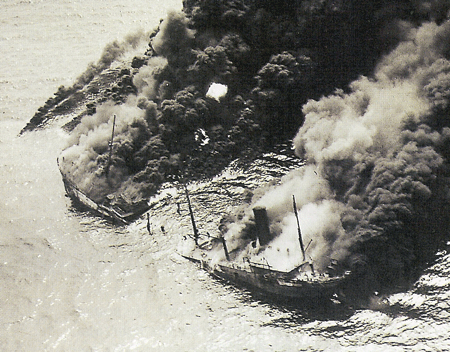The Secret of History of Hatteras Island: A Guest Post by Newbery Honor Winning Author Sheila Turnage

Each year, thousands of vacationers visit North Carolina’s Outer Banks, whose shores often top Best Beaches lists. People drive over from the mainland, sail across the Pamlico Sound, or putter over on pug-faced ferries. They come for endless beaches and rolling dunes. For fishing and wild ponies. They come to climb the Hatteras Lighthouse.
Maybe, like me, they also come for Hatteras Island’s World War II history—a story I stumbled onto a half-century ago as I strolled a white sand beach with my father. “What’s that?” I asked, pointing to a black patch on the sand.
ADVERTISEMENT
ADVERTISEMENT
“Oil,” he said. “In World War II, German U-Boats sat right out there, torpedoing our ships. The ships still sit on the bottom of the sea, leaking oil. That’s our secret history.”
And that’s how I met the backstory for my latest middle-grade novel, Island of Spies, set on Hatteras Island in 1942.In case you’re not familiar, here’s the scoop:
At the start of World War II—before the bridges—Hatteras Island was a world apart. It owned no paved roads. A single bus puttered over the sand, stitching together tiny villages along the Pamlico Sound. Men fished or traded, women ran households. Children went to combined-grade schools where “quit-uating” was as good as graduating.
Offshore, shifting sandbars and deadly currents created some of the most dangerous waters in the world—”the Graveyard of the Atlantic.”
In January of 1942, as Island of Spies opens, those waters become even deadlier.
Japan has bombed Pearl Harbor just weeks before, crippling America’s navy. While America looks westward, fearing another attack, Nazi Germany strikes from the east—sending German subs, called U-boats, across the Atlantic to Hatteras Island, and into some of the richest shipping lanes in the world.
blam!

A ship called the City of Atlanta takes a torpedo strike and explodes, rattling windows and shaking islanders’ nerves. As my main characters—Stick, Neb, and Rain—watch the ship sink, protagonist Stick Lawson feels it in her bones: Change has come to Hatteras Island.
Stick and friends wait for help, just as islanders did in real life. But thanks to Pearl Harbor, America has no ships to send. As in history, U-boats pick off oil tankers, trawlers, and freighters at leisure. In six months, U-boats sink more than eighty ships along the North Carolina coast, with hundreds of lives lost. The government marks as muchnews as possible classified, to keep an already frightened nation from panicking.
Hatteras Island is on its own.
In Island of Spies, as rumors of Nazi agents race up and down the coast, Stick and her friends—aka The Dime Novel Kids—assign themselves a tough case: to capture a spy. It’ll help them earn the respect of islanders (unlikely), protect a world they love, and maybe even snag a prime assignment from the FBI, who refuses to write them back.
Island of Spies isn’t a war story, but the war provides a dramatic backdrop for a book about friendship, fathers, and the strangest kids on the island. It’s about being invisibilized and willing yourself visible again. About recognizing friends in enemies and enemies in friends. About standing up to prejudice, keeping your cool undercover, and learning to count on each other—no matter what.
Still, its backstory—the history—is worth a look next time you visit Hatteras Island. There’s no museum dedicated to it, but its footprints lead to scattered museum exhibits, dive shops . . . even to a seafood dinner. If you like history (or even if you don’t and it’s raining on your vacation), it’s a trail worth following.
The Graveyard of the Atlantic Museum, on the island’s southern tip, covers centuries of maritime history, and houses World War II Coast Guard uniforms and artifacts, U-boat armaments, and my favorite item: the U-85’s enigma machine, which encoded and decoded U-boat messages. You can almost feel a young sailor’s fingertips hovering over the keys—a feeling I blended into Island of Spies.

Last time I visited, tableaus of furniture, doors, mirrors, and books washed ashore from shipwrecks and used in island homes intrigued me. The exhibit may have rotated on, but you’ll see evidence of that intrigue in Stick’s mother’s library, and in Stick’s encyclopedias—complete except for the missing volume K.
Near Rodanthe, you’ll find the Life-Saving Station, one of the most complete historic life-saving sites in the nation. (If you can’t pronounce Chicamacomico, don’t feel alone. One of my characters can’t, either.) I love the feel, pride, and swagger of this place. Among the displays in this five-building site, you’ll see the World War II uniforms Coast Guard members wore as they watched for attacks during Stick’s time. You’ll see medals and shipwreck artifacts, and you can see and touch the kind of rescue skiff the Dime Novel Kids longed to see as the U-boats’ first victim, the City of Atlanta, went down in the waters off their island in 1942. You’ll hear tales of famous sea rescues involving the islanders who staffed the station. Just ask the docents to point you to the World War II artifacts.
(Confession: I snagged a few details from this site’s Cook House and the 1907 Midgett House for Stick’s home. Check out the floor pattern in the living room of the Midgett House, for instance, and then check Stick’s.)

With so many ships down in 1942 (and over the centuries, really), the waters off the Outer Banks offer the best wreck diving along the East Coast. Dave Sommers, an owner of Dive Hatteras LLC in Frisco, says certified divers love the Dixie Arrow, both for its history of heroism and easy access. The ship went down in 1942, and lies in ninety feet of water.
But favorites do change. As always, shifting currents rule the Graveyard of the Atlantic. The Australia (1942), in about a hundred feet of water, teemed with divers and sharks until changing currents recently covered ninety percent of the wreck in sand. There’s no lack of sites waiting to take its place, though, including the popular World War II wrecks the Empire Gem and the Kassandra Louloudis.
In the interest of equal time, when it comes to U-boats, the U-352 is popular, but you’ll have to leave the island to dive it. It’s located to the south, across from Morehead City, North Carolina.
If you prefer the restful nature of cemeteries to wreck diving and sharks, as I do, check out the tiny Buxton British Cemetery, which honors men who went down with the British tanker San Delfino in 1942. The last time I visited, people had left an odd but touching collection of gifts—a flower, coins, and a bottle of beer left open in salute.
ADVERTISEMENT
ADVERTISEMENT
And if you like a side of history with your dinner, stop by Owen’s Restaurant in Nags Head. You’ll find a museum-worthy collection of artifacts in the lobby and at least one 1946 recipe on the menu. (I’m looking at you, crab cakes.)
Finally, the 30,000-plus-acre Cape Hatteras National Seashore, so often voted a top US beach, offers a chance to explore the island Stick, Rain, and Neb knew in 1942—including the lighthouse they took as their headquarters. Occasionally, World War II artifacts still roll ashore along park beaches, I hear, but you’re much more likely to find seashells. Check out the excellent park programs, and soak in the sound of the rolling surf, the cry of gulls, the wide-open promises of the sea. (Swim only in waters overseen by park lifeguards, and follow the park’s other safety tips.)
You won’t find the globs of oil I stumbled into a half-century ago, park rangers say. They’re a thing of the past.
But Hatteras Island’s secret World War II history shadows almost every inch of this island, offering vacationers a meandering Plan A History Excursion, or a Rainy Day Plan B Tour. And providing me a super backstory for Island of Spies.
See you there.
Growing up in eastern North Carolina, Newbery Honor author Sheila Turnage fell in love with Hatteras Island’s shipwrecks, secret World War II history, and whispered spy stories—which helped inspire her latest middle grade novel Island of Spies. The story is based on real-life U-boat torpedo attacks off Hatteras Island, and invites us into a world of history and mystery.
Filed under: Guest Posts
About Betsy Bird
Betsy Bird is currently the Collection Development Manager of the Evanston Public Library system and a former Materials Specialist for New York Public Library. She has served on Newbery, written for Horn Book, and has done other lovely little things that she'd love to tell you about but that she's sure you'd find more interesting to hear of in person. Her opinions are her own and do not reflect those of EPL, SLJ, or any of the other acronyms you might be able to name. Follow her on Twitter: @fuseeight.
ADVERTISEMENT
ADVERTISEMENT
SLJ Blog Network
The Moral Dilemma of THE MONSTER AT THE END OF THIS BOOK
Winnie-The-Pooh | Review
Parsing Religion in Public Schools
ADVERTISEMENT







